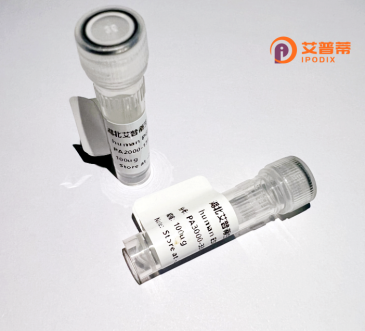
| 纯度 | >90%SDS-PAGE. |
| 种属 | Human |
| 靶点 | ARHGEF4 |
| Uniprot No | Q9NR80 |
| 内毒素 | < 0.01EU/μg |
| 表达宿主 | E.coli |
| 表达区间 | 1-690aa |
| 氨基酸序列 | MPWEEPAGEKPSCSHSQKAFHMEPAQKPCFTTDMVTWALLCISAETVRGEAPSQPRGIPHRSPVSVDDLWLEKTQRKKLQKQAHVERRLHIGAVHKDGVKCWRKTIITSPESLNLPRRSHPLSQSAPTGLNHMGWPEHTPGTAMPDGALDTAVCADEVGSEEDLYDDLHSSSHHYSHPGGGGEQLAINELISDGSVVCAEALWDHVTMDDQELGFKAGDVIEVMDATNREWWWGRVADGEGWFPASFVRLRVNQDEPADDDAPLAGNSGAEDGGAEAQSSKDQMRTNVINEILSTERDYIKHLRDICEGYVRQCRKRADMFSEEQLRTIFGNIEDIYRCQKAFVKALEQRFNRERPHLSELGACFLEHQADFQIYSEYCNNHPNACVELSRLTKLSKYVYFFEACRLLQKMIDISLDGFLLTPVQKICKYPLQLAELLKYTHPQHRDFKDVEAALHAMKNVAQLINERKRRLENIDKIAQWQSSIEDWEGEDLLVRSSELIYSGELTRVTQPQAKSQQRMFFLFDHQLIYCKKDLLRRDVLYYKGRLDMDGLEVVDLEDGKDRDLHVSIKNAFRLHRGATGDSHLLCTRKPEQKQRWLKAFAREREQVQLDQETGFSITELQRKQAMLNASKQQVTGKPKAVGRPCYLTRQKHPALPSNRPQQQVLVLAEPRRKPSTFWHSISRLAPFRK |
| 分子量 | 75.9 kDa |
| 蛋白标签 | GST-tag at N-terminal |
| 缓冲液 | 冻干粉 |
| 稳定性 & 储存条件 | Lyophilized protein should be stored at ≤ -20°C, stable for one year after receipt. Reconstituted protein solution can be stored at 2-8°C for 2-7 days. Aliquots of reconstituted samples are stable at ≤ -20°C for 3 months. |
| 复溶 | Always centrifuge tubes before opening.Do not mix by vortex or pipetting. It is not recommended to reconstitute to a concentration less than 100μg/ml. Dissolve the lyophilized protein in distilled water. Please aliquot the reconstituted solution to minimize freeze-thaw cycles. |
以下是3条关于ARHGEF4的研究文献摘要概览:
1. **标题**:*ARHGEF4 regulates apoptosis in hepatocellular carcinoma cells through RhoA-dependent autophagy activation*
**作者**:Chen, Y., et al.
**摘要**:该研究发现ARHGEF4在肝癌细胞中通过激活RhoA信号通路促进自噬,进而抑制细胞凋亡,提示其在肝癌进展中的促生存作用。
2. **标题**:*Genetic association of ARHGEF4 with autism spectrum disorder through impaired synaptic plasticity*
**作者**:Li, X., et al.
**摘要**:研究通过基因关联分析发现ARHGEF4突变与自闭症相关,实验表明其缺失导致神经元突触可塑性异常,可能与Rho GTPase信号失调有关。
3. **标题**:*Structural basis of ARHGEF4 activation by the scaffold protein SmgGDS*
**作者**:Hertzog, J.J., et al.
**摘要**:该研究解析了ARHGEF4与SmgGDS蛋白的相互作用结构,揭示SmgGDS通过招募ARHGEF4至细胞膜增强其对RhoA的鸟苷酸交换活性。
ARHGEF4 (Rho Guanine Nucleotide Exchange Factor 4), also known as GEF-H1 or KIAA1411. is a member of the Dbl family of RhoGEFs that activates Rho GTPases such as RhoA and Cdc42 by catalyzing the exchange of GDP for GTP. It plays critical roles in regulating cytoskeletal dynamics, cell migration, adhesion, and proliferation through Rho-dependent signaling pathways. Structurally, ARHGEF4 contains a catalytic Dbl homology (DH) domain and a pleckstrin homology (PH) domain, along with additional motifs enabling interactions with microtubules and other signaling molecules.
Originally identified as a microtubule-associated protein, ARHGEF4 links cellular architecture to mechanical signaling. Its activity is tightly regulated by spatial localization; microtubule binding suppresses its GEF function, while mechanical stress or microtubule disassembly triggers Rho pathway activation. Dysregulation of ARHGEF4 has been implicated in pathological conditions, including cancer progression (e.g., hepatocellular carcinoma, colorectal cancer) and neurological disorders. Studies suggest its overexpression promotes tumor cell invasion by enhancing actomyosin contractility, while loss-of-function mutations or altered expression may contribute to neurodevelopmental defects.
Recent research also highlights its role in immune responses and epithelial barrier integrity. Despite these advances, context-dependent regulatory mechanisms and tissue-specific functions of ARHGEF4 remain active areas of investigation.
×